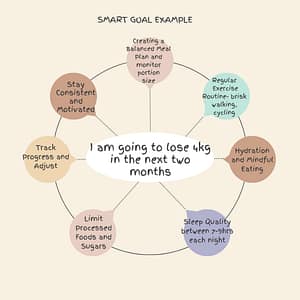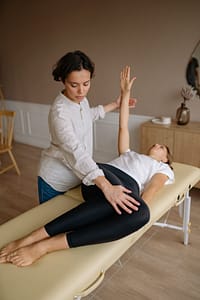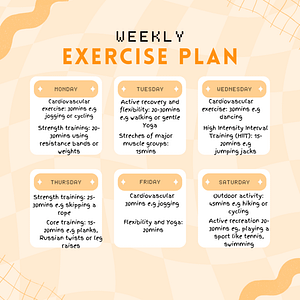As a fitness instructor who specializes in working with menopausal women, I understand the unique challenges we face in 2025 when starting or returning to exercise. Hot flashes, joint sensitivity, and changing energy levels can make traditional workout routines feel overwhelming. But don’t worry – I’m here to guide you through creating a workout routine during menopause that works with your body, not against it.
Understanding Your Menopausal Body
Before we dive into the workout routine, let’s acknowledge what makes our journey unique:
– Hormonal fluctuations affecting energy and mood
– Increased need for bone-strengthening exercises
– Joint sensitivity requiring low-impact options
– Temperature regulation challenges during workouts
– Potential weight distribution changes
Considerations When Creating a Workout Routine During Menopause
Let me guide you through important considerations when creating a workout routine during menopause. I’ll help you understand which exercises deserve extra caution during this life stage.
High-Intensity Interval Training (HIIT).
While I recommend HIIT for its cardiovascular benefits, you’ll need to approach it carefully. The high-impact nature of these workouts can be tough on your joints and may increase injury risk if not done properly. I’ve found that many women benefit from starting with modified, lower-impact versions of HIIT exercises.
Strength Training
I want to emphasize the importance of proper form. During menopause, our bodies experience hormonal changes that can affect bone density, making us more susceptible to fractures. That’s why I strongly advise against heavy lifting without proper technique. Here’s what I’ve learned about weight training during menopause:
– While lighter weights with higher repetitions work well for beginners – Research shows that heavier weights with lower repetitions can be more effective for building muscle mass
– The key is to progress gradually and maintain proper form throughout I particularly want to caution you about exercises involving extreme spinal movements.
Avoid:
– Excessive spine flexion
– Extreme extension
– Rapid rotational movements
Instead, I recommend focusing on:
– Exercises that promote spinal stability
– Core-strengthening movements
– Low-impact activities like Pilates or yoga
Remember, creating a safe and effective workout routine during menopause isn’t about avoiding exercise altogether – it’s about choosing the right activities and performing them correctly. By following these guidelines, you can maintain your fitness while protecting your body during this important life transition.
Weight Training for Menopause Weight Loss: A Beginner’s Guide
I want to share how weight training can be a game-changer for women experiencing menopause, especially when it comes to weight management and overall health. Let me walk you through why it’s so important and how to get started.
During menopause, I’ve seen how hormonal changes can impact our bodies – particularly with muscle loss and increased body fat. That’s why I strongly recommend incorporating weight training into your routine. It helps build lean muscle, boost metabolism, and burn more calories, even when you’re resting.
Here’s my recommended beginner-friendly approach: Starting Basics:
• Begin with bodyweight exercises to master form,• Use light weights (2-5 pounds) for upper body
• Practice with 5-10 pounds for lower body exercises • Aim for 2-3 sets of 12-15 repetitions
Essential Exercises I Recommend:
1. Lower Body
– Squats (start with bodyweight) – Lunges (static, then walking) – Modified deadlifts
2. Upper Body – Wall push-ups – Seated rows – Shoulder presses
For optimal results, I suggest combining weight training with aerobic exercise. According to UCLA Health research, this combination is particularly effective for menopausal women, improving cardiovascular health and insulin sensitivity while reducing visceral fat. I recommend starting with two 30-minute sessions per week, gradually building up to three sessions as your strength and confidence grow. Remember, this journey is about progress, not perfection!
Creating Your Custom Routine
I recommend starting with these menopause-friendly elements:
– Gentle warm-ups to protect joints
– Weight-bearing exercises for bone health
– Modified cardio that won’t trigger hot flashes
– Strength training to maintain muscle mass
– Cooling-down stretches for flexibility
Sample Weekly Schedule
Here’s what I suggest for beginners:
– Monday: 20-minute walking with arm movements
– Tuesday: Gentle yoga or stretching
– Weekend: Active recovery with nature walks
Remember, this is your journey, and I’m here to support you in creating a sustainable routine that honors your body’s changes while building strength and confidence. Let’s embrace this new chapter together with exercises that make you feel empowered and energized.
Understanding the 6-12-25 Method for Menopausal Women
As someone who’s worked extensively with menopausal women, I’m excited to share how the 6-12-25 method can be particularly beneficial during this life transition. This structured workout protocol is especially valuable for maintaining bone density and muscle mass – two key concerns during menopause.
The Basic Framework with Menopausal Modifications
Let me break down how we can adapt this method specifically for menopausal women:
First Set (6 reps): We’ll use heavy weights to build bone density and core strength – Choose compound movements like squats or deadlifts – Focus on proper form to protect joints – Include balance elements to prevent falls
Middle Set (12 reps): This targets muscle preservation and metabolic health – Incorporate movements that engage multiple muscle groups – Maintain moderate resistance to support hormonal balance – Add variations that improve posture
Final Set (25 reps): Designed for endurance and cardiovascular health – Use lighter weights with controlled movements – Include low-impact alternatives – Focus on maintaining core temperature regulation
Special Considerations for Menopausal Women
I recommend these specific modifications for menopausal women:
– Schedule workouts during cooler parts of the day to manage hot flashes
– Include longer warm-ups to protect joints
– Take brief rest periods between sets if needed
– Stay well-hydrated throughout the workout
– Monitor intensity levels and adjust as needed
Getting Started Safely
For my menopausal clients, I always emphasize starting gradually and listening to your body.
Begin with lighter weights and perfect your form before increasing intensity. This method is particularly effective because it combines strength training for bone health with endurance work for cardiovascular benefits – both crucial during menopause.
For more detailed information about this method and its benefits, you can explore resources from JR Training Systems and Health Shots. Remember, this is not just about exercise – it’s about maintaining strength, independence, and vitality during menopause and beyond. By adapting the 6-12-25 method to your specific needs, you’re investing in your long-term health and well-being.
1. Setting Clear Fitness Goals
As a menopausal woman, I know how important it is to set realistic fitness goals. I focus on specific objectives like managing weight gain, maintaining bone density, and reducing hot flashes through exercise. Let’s create goals that address our unique needs during this transition.
2. Understanding Your Current Fitness Level
I recommend starting with an honest assessment of where you are right now. Consider how menopause symptoms like joint pain or fatigue affect your exercise capacity. For example, if you experience morning stiffness, afternoon workouts might work better for you.
3. Getting Expert Help
I always suggest working with trainers who specialize in menopausal fitness. They can help modify exercises to accommodate common issues like pelvic floor weakness or osteoporosis concerns.
4. Finding Your Joy in Movement
Choose activities that make you feel good! Low-impact options like water aerobics, yoga, or strength training can be gentler on our joints while still being effective. I’ve found that group classes specifically for menopausal women create both enjoyment and support.
5. Planning Your Week
Create a schedule that works with your energy levels. I recommend exercising during your peak energy times and including rest days when needed. For example, try strength training in the morning when hormone levels are optimal.
6. Building Gradually
Start with just 10-15 minutes of exercise and slowly build up. Listen to your body – some days you might need to dial back intensity, especially during hot flashes or high-stress periods.
7. Mixing It Up
- Combine weight-bearing exercises for bone health
- Add balance work to prevent falls
- Include pelvic floor exercises in your routine
- Try gentle cardio for heart health and mood regulation
8. Mastering Proper Form
I emphasize form over everything else. For example, when doing squats, control your movements and focus on engaging your core to protect your pelvic floor. If something doesn’t feel right, modify or seek guidance from a professional who understands menopausal fitness needs.
9. Fueling Your Fitness During Menopause
I want to emphasize how crucial proper nutrition becomes during menopause. I recommend focusing on some menopause-friendly foods like:
– Leafy greens for calcium to support bone health
– Fatty fish for omega-3s
– Lean proteins for muscle maintenance
Remember to stay well-hydrated – I suggest keeping a water bottle with you throughout the day.
10. Listening to Your Changing Body
During menopause, your body sends different signals than before. I’ve found that paying special attention to joint comfort and energy levels is essential. If you’re experiencing hot flashes during workouts, I recommend scheduling exercise during cooler hours and wearing moisture-wicking clothing.
11. Recovery: Your Secret Weapon
- I strongly advocate for regular rest days, especially if you’re dealing with menopause-related fatigue. Consider gentle activities like walking or stretching on these days.
12. Sleep Strategies

I know sleep can be challenging during menopause, but it’s crucial for recovery.
I recommend:
– Creating a cool sleeping environment
– Maintaining a consistent bedtime routine
– Avoiding screens before bed
– Using breathable bedding
13. Tracking Your Menopause Fitness Journey
- I suggest tracking not just your workouts but also your energy levels, mood, and menopause symptoms. This helps identify patterns and optimize your routine.
14. Mindfulness for Menopause
I’ve found that mindfulness practices are particularly beneficial during menopause. Try incorporating breathing exercises during hot flashes or gentle yoga to improve flexibility and reduce stress.
15. Finding Your Support Group
I recommend connecting with other women experiencing similar changes. Consider joining menopause-specific fitness groups or online communities where you can share experiences and support each other.
16. Adapting to Change
I want you to remember that menopause is a transition, and your fitness routine should evolve with you. Be flexible with your goals and celebrate small victories along the way.
17. Staying Consistent and Patient During Menopause
As a woman navigating menopause, I understand that consistency is especially vital during this hormonal transition. Our bodies are experiencing significant changes, and maintaining a regular exercise routine can help manage common symptoms like hot flashes, mood swings, and weight fluctuations.
During my fitness journey, I’ve learned that progress might be slower during menopause due to hormonal changes, but that doesn’t make it any less valuable. Small victories, like completing a full workout without modification or noticing improved sleep quality, deserve celebration. The key is maintaining dedication while being gentle with ourselves.
By following this comprehensive guide tailored for menopausal women, we can create a workout routine that addresses our unique needs. This includes incorporating strength training to maintain bone density, low-impact cardio to protect our joints, and flexibility work to maintain mobility.
18. Adapting Your Routine for Long-Term Success
I’ve found that our fitness journey during menopause offers numerous benefits beyond physical changes. Regular exercise can help stabilize mood swings, reduce hot flashes, and improve sleep quality. Remember, this is a time to focus on overall well-being rather than just aesthetic goals.
As we progress, it’s natural to modify our routines based on how we’re feeling day by day. Some days, you might need to reduce intensity due to fatigue or joint discomfort, while others, you might feel energized for a more challenging workout. The key is maintaining consistency while honoring our body’s changing needs.
Let’s start this fitness journey together, understanding that each step forward supports our health during this significant life transition. Whether you’re just beginning perimenopause or well into your postmenopausal years, it’s never too late to prioritize your fitness and well-being. Here’s to creating sustainable, enjoyable workout habits that serve us well through 2025 and beyond!
Effective workout routine during menopause
This website may contain affiliate links, and we may earn a commission for any purchases you make on affiliate websites using these links. Our affiliates include Amazon. Rest assured, these affiliate links come at no additional cost to you.





The article posted was very informative and useful. You people are doing a great job. Keep going.
Thank you
Wellness Junction
This is such a great post, and was thinking much the same myself. Another great update.
Hello
What else would you like us to write about?
Wellness Junction
Pingback: 15 Secrets To Sustainable Weight Loss After 40
Pingback: Poop Like a King: Reignite Your Gut Health with Royal Rituals
Comments are closed.